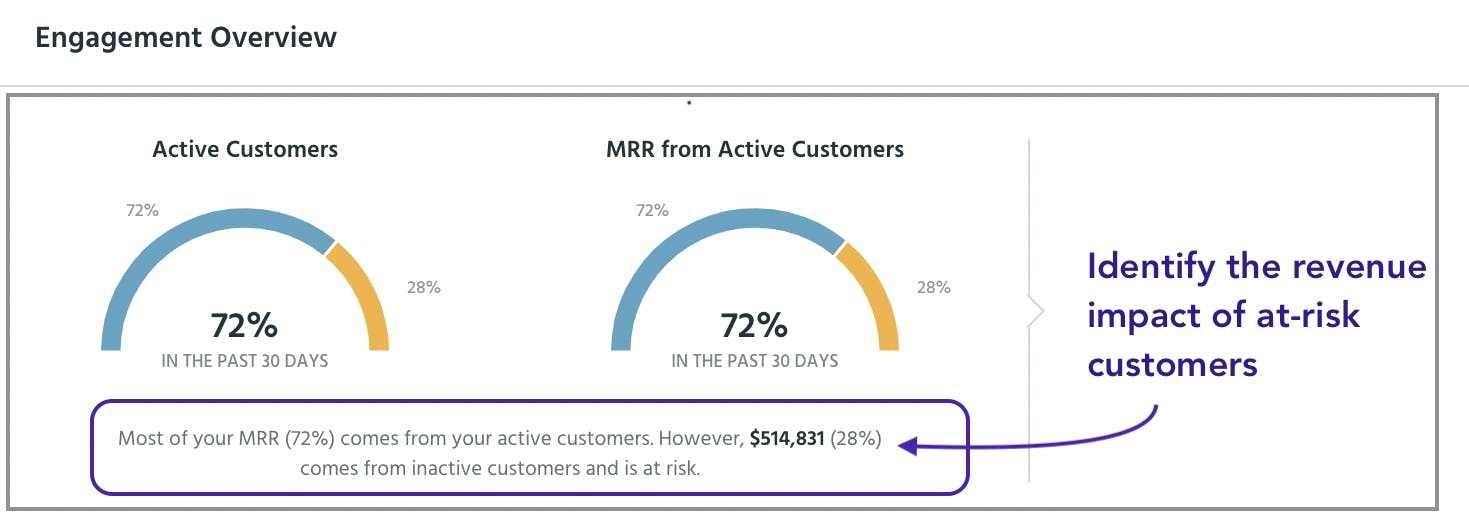The efficiency of customer retention efforts is hard to underestimate. With 80% of your future profits coming from 20% of existing customers, the ability to keep them loyal is the key to success.
Your customer retention results depend on your ability to analyze them. Knowing when to make a small change or where to take a sharp turn can help you capitalize on retention efforts and cut marketing costs.
Let's dive a little deeper into what customer retention analysis is and how to get the most out of it.
What is retention analysis?
Retention analysis (or survival analysis) is the process of analyzing user metrics to understand how and why customers churn. Retention analysis is key to gain insights on how to maintain a profitable customer base by improving retention and new user acquisition rates.
By running consistent retention analysis, you'll learn:
- Why customers are churning.
- When customers are more likely to leave.
- How churn affects your bottom line.
- How to improve your retention strategies.
Overall, this analysis allows you to see how well your customer retention efforts are working. Without it, you may end up spending your marketing budget inefficiently
How customer retention analysis works
Conducting a customer retention analysis is much more than calculating the churn rate. To get a clear picture, you need to figure out where, how, and why your customers leave.
These insights can help you adjust the retention strategy and achieve sustainable business growth.
Identify where customers churn
An efficient retention analysis can help you understand at which point in their journey, your customers are more likely to churn.
By studying your existing customers' behavior and the retention rate fluctuations, you can find out which stage of the new user journey is highly volatile.
Once you have this information, you can adjust the marketing strategy to improve the retention efforts at the most vulnerable part of the customer's lifecycle and increase the number of users that stick with your product.
The key to identifying where customers churn is the continuous analysis of their behavior, right from onboarding, with retention and churn rates in mind.
Determine why customers churn
Retention analysis can show you the number of customers who churn and why. By doing this, you can identify behaviors associated with churning and acquire direct feedback.
Figuring out when customers leave you, can help you identify weak spots in your strategy. Meanwhile, feedback offers a direct explanation of why a customer decides to churn.
By adjusting your business strategy to battle the common reasons for churning, you can increase retention rates quickly and efficiently.
Find out how to improve retention
A smart customer retention analysis allows you to understand what you've done wrong. Knowing where and why customers churn can help you single out weak parts of your marketing and retention strategies and fix them timely.
A variety of retention improvement tactics exist. Many companies make a mistake of employing them without analyzing the situation first. With retention analysis results in hand, you can pinpoint strategies that work specifically for your business.
How to do retention analysis in 6 steps
The key to getting the most of your retention analysis is conducting it regularly. Customer behavior changes over time and so does your product offering. Seeing the full picture is only possible when you analyze customer cohorts consistently and continuously.
Step 1. Calculate your retention rate
Your customer retention rate is the starting point of any retention analysis. You need to know how many customers are staying and how many are leaving. Even if the rate is satisfactory, you still need the analysis to continue keeping it this way. There are different angles to consider when calculating your retention rate to get the most useful insight:
Define what retention means for your business
Customer retention can have a slightly different meaning for different companies. What do you expect to achieve by improving the customer retention rate?
- Spend less money on customer retention
- Increase revenue
- Build better customer relationships
- Improve marketing strategies
Depending on how big your clients are, you may want to calculate revenue retention (also called dollar retention) along with the customer retention rate. Losing one big customer may affect the revenue tremendously while increasing the customer retention insignificantly.
Conduct cohort analysis based on timeframe and persona
To get more information from your analysis, divide your customers into cohorts and personas. A cohort or a customer persona is a group of customers, who share the same characteristics.
Time-based cohorts is a group that signed up for your services at around the same time. Studying their actions for retention helps you understand how many of them continue to be active users for weeks/months/years. Cohort retention analysis gives you a better understanding of buyer behavior and reasons for churning based on your analysis parameters.
By dividing your customers into personas that share similar characteristics (customer time with product, use of certain features, demographics), you can get a better idea of what works and what doesn't for a certain group. This can help you adjust your retention strategies "in bulk".
Track user behavior from acquisition to attrition
The way your customers behave during their lifecycle is the raw data you need to conduct the retention analysis.
The retention rate across the customer lifetime isn't uniform. That's why you need to know what happens during each of the stages. Meanwhile, keeping a growing customer base with your company requires different actions at different stages. Your user retention strategy will be different for new users versus seasoned power users.
Step 2. Choose retention KPIs
To take the retention analysis in the right direction, you need to identify metrics that you associate with engagement. Some common key KPIs are:
- Customer churn rate: customers that leave after subscribing.
- Customer lifetime value: the total amount the customer is expected to spend on your product.
- Customer engagement score: evaluates customer engagement and free trial prospects.
- Net Promoter Score: how many customers recommend your product to others.
- MRR churn rate: lost revenue due to lost customers.
By analyzing your KPI-related goals, you can take your customer retention strategies to a new level.
Each business has specific metrics that it associates with customer engagement. For example,
- Number of upgrades
- Frequency of feedback
- Participation in loyalty programs
- And more
Consider these KPIs as well when analyzing your customer behavior and rethinking your retention tactics.
Step 3. Flag behaviors that indicate churn risk for at-risk customers
By tracking customer behavior and reviewing certain patterns, you can develop an idea of what indicates future churn and build better customer segmentation.
Some useful questions to ask are:
- Do users that take advantage of a certain feature have a higher churn rate?
- Do customers who access three features each month have a lower churn rate?
- Do users who contact customer service more than twice a month have a higher churn rate?
You can get highly valuable data by analyzing churned customer behavior. You may want to consider sending out surveys to help with gathering information. In many cases, past customers are more than happy to provide feedback.
Once you flag risky behavior, you can channel your efforts into retaining clients who exhibit it. You may have to work out a separate strategy for each behavioral pattern.
Step 4. Determine churn triggers for each cohort & persona
To target your retention efforts toward areas where customers typically churn, you don't just need to look at the previous behavior, you should make some churn predictions.
The ability to predict where a particular persona or cohort is at a high risk of churning is a formidable potential revenue source for a SaaS company.
Considering the loss of revenue associated with the loss of clients coupled with high customer acquisition costs, each prevented churn is virtually priceless.

With a tool like Profitwell, you can make predictions by taking full advantage of behavioral patterns and retention metrics. While the accuracy of such predictions may vary, you are likely to get an approximate picture of where the groups are more likely to churn in the future. This will be enough to take specific actions to retain them.
Step 5. Identify behaviors associated with churn and retention
The next step is to track customers who stay with your product for a long period of time. Your retention tactics seem to be working for these people. Examine their behavior to come up with patterns that appear to be associated with retention.
By comparing their patterns to the patterns of customers who churn, you can identify where and how your customers are likely to leave.
Try to follow how the behavior of your customers changes after introducing certain retention measures or launching a new feature. Such data gathering takes time. That's why it's extremely important to perform retention analysis regularly.
Step 6. Get direct feedback from customers
You can conduct customer surveys or ask for feedback while they are using your product. This can give you valuable insight into what you are doing right or wrong. You can also take advantage of their suggestions to beef up retention efforts.
Don't hesitate to ask past customers for feedback, as well. Unhappy clients are often more likely to give feedback than satisfied customers are.
Churn surveys are highly useful for SaaS companies. They ask clients to choose the biggest and smallest reason they are churning.
Understand your retention metrics with Paddle's ProfitWell Metrics
When it comes to customer retention, knowing your numbers is essential. The ability to identify and understand metrics can help you adjust the retention strategy and boost marketing efforts.
To run a top-notch customer retention analysis, you need to identify the metrics to work with and learn how to wield them timely. Without a clear understanding of what these numbers mean, it's hard to adjust your retention and marketing tactics.
By signing up for ProfitWell Metrics, you can get access to a highly accurate retention reporting platform to drive customer success, as well as visualizations of numbers and insights that give you an opportunity to achieve sustainable business growth. This tool can help you gather the most valuable data to conduct precise retention analysis.
The takeaway
Retention analysis is an integral part of your customer retention and marketing strategies.
By taking full advantage of the data you collect by tracking customer behavior, requesting feedback, and studying important metrics, you can decrease the churn rate, improve customer satisfaction, and boost your revenue.




